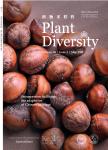Phytosociology of stratification in a lowland tropical rainforest occurring north of the Tropic of Cancer in Meghalaya, India
Phytosociology of stratification in a lowland tropical rainforest occurring north of the Tropic of Cancer in Meghalaya, India作者机构:Department of Botany North-Eastern Hill University
出 版 物:《Plant Diversity》 (植物多样性(英文版))
年 卷 期:2019年第41卷第5期
页 面:285-299页
核心收录:
学科分类:0710[理学-生物学] 0830[工学-环境科学与工程(可授工学、理学、农学学位)] 07[理学] 0901[农学-作物学] 0902[农学-园艺学] 0701[理学-数学] 0713[理学-生态学]
基 金:the Department of Biotechnology,Ministry of Science and Technology,Government of India,New Delhi through grant number BT/PR7928/NDB/52/9/2006 to the author Financial support for visit to China was received under the INSA-CAS Bilateral Exchange Programme 2018 from the Indian National Science Academy,New Delhi and Chinese Academy of Sciences,Beijing vide grant number INT/CAS/2017/01
主 题:Forest stratification Stand structure Storey structure Loftiness Population structure Northeast India
摘 要:Stratification in lowland rainforests of Meghalaya,India,which represent the westernmost limit of the rainforests north of the Tropic of Cancer,was studied in horizontal and vertical planes to elucidate the patterns in stacking of species diversity and community attributes,and to draw comparisons with rainforests of‘Indo-Malaya’ecozone(biogeographical realm).All individuals≥10 cm GBH(girth at breast height)were enumerated in six transects of 10 m width and up to 500 m length covering 2.45 ha area.The stratification of whole assemblage of species in vertical plane is referred to as‘storey structure’(=height class distribution),which explains structural complexity.In horizontal plane,it is typically referred to as‘stand structure’(=girth class distribution),which explains structural heterogeneity.The stratification of an individual species in vertical plane is referred to as‘loftiness’and in horizontal plane,it is frequently referred to as‘population structure’.The stand structure was characterized by a negative exponential relationship or a reverse J-shaped curve,which is typical of a well regenerating forest stand.The storey structure was characterized by the low stature of the rainforest(30 m),subtle layering in the canopy with dearth of discrete multi-stories,narrower widths of the stories and a thick understory.The cluster analysis and‘candlestick charts’showed that the dominant species spatially segregated in canopy height to profile three strata,viz.,an understory of juveniles and shrubs below 5 m,a middle-storey of intermediate trees between 5 and 15 m,and an overstory of large trees between 15 and 25 m.Emergent trees of a few species may reach up to 30 m.The individuals tended to scatter in increasingly wider range of height classes from a lower to the next higher girth class,creating a‘torchlight scatter’pattern,with a tendency to concentrate towards smaller height classes due to stochastic factors,which potentially influence vertical growth proportionate to diametric growth.In comparison to equatorial rainforests of Malaysia and seasonal rainforests of southwestern China,the rainforests of Meghalaya are short-statured at the geographic extremity of the occurrence of rainforest biome in Asiae Pacific region,owing to floristic composition,site quality factors,excessively higher quantities of rainfall and high differential of precipitation and potential evapotranspiration.Despite limited diversity of megaphanerophytes,these rainforests deserve concerted conservation efforts as they stack high diversity of meso-,micro-and nano-phanerophytes.



